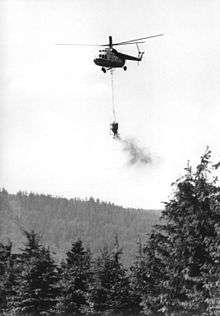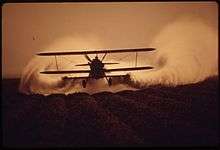Aerial application
Aerial application, or what is informally referred to as crop dusting, involves spraying crops with crop protection products from an agricultural aircraft. Planting certain types of seed are also included in aerial application. The specific spreading of fertilizer is also known as aerial topdressing in some countries. Many countries have severely limited aerial application of pesticides and other products because of environmental and public health hazards like spray drift; most notably, the European Union banned it outright with a few highly restricted exceptions in 2009,[1] effectively ending the practice in all member states.


_takes_off_at_Devonport_Airport.jpg)

Agricultural aircraft are highly specialized, purpose-built aircraft. Today's agricultural aircraft are often powered by turbine engines of up to 1,500 shp (1,100 kW) and can carry as much as 800 US gallons (3,000 l) of crop protection product. Helicopters are sometimes used, and some aircraft serve double duty as water bombers in areas prone to wildfires. (These aircraft are referred to as SEAT, "single engine air tankers").
History
Aerial Seed Sowing 1906
The first known aerial application of agricultural materials was by John Chaytor, who in 1906 spread seed over a swamped valley floor in Wairoa, New Zealand, using a hot air balloon with mobile tethers. Aerial sowing of seed still continues to this day with cover crop applications and rice planting.
Crop Dusting 1921
The first known use of a heavier-than-air machine to disperse products occurred on 3 August 1921.[2] Crop dusting was developed under the joint efforts of the US Agriculture Department, and the US Army Signal Corps's research station at McCook Field in Dayton, Ohio.[2] Under the direction of McCook engineer Etienne Dormoy, a United States Army Air Service Curtiss JN4 Jenny piloted by John A. Macready was modified at McCook Field to spread lead arsenate to kill catalpa sphinx caterpillars at a Catalapa farm near Troy, Ohio in the United States.[2][3] The first test was considered highly successful.[2] The first commercial operations were begun in 1924, in Macon, Georgia,[4] by Huff-Daland Crop Dusting, which was co-founded by McCook Field test pilot Lt. Harold R. Harris.[2] Use of insecticide and fungicide for crop dusting slowly spread in the Americas and to a lesser extent other nations in the 1930s. The name 'crop dusting' originated here, as actual dust was spread across the crops. Today, aerial applicators use liquid crop protection products in very small doses.
Top dressing 1939–1946
Aerial topdressing is the aerial application of fertilisers over farmland using agricultural aircraft. It was developed in New Zealand in the 1940s and rapidly adopted elsewhere in the 1950s.
Purpose-built aircraft
In 1951, Leland Snow begins designing the first aircraft specifically built for aerial application, the S-1. In 1957, The Grumman G-164 Ag-Cat is the first aircraft designed by a major company for ag aviation. Currently, the most common agricultural aircraft are the Air Tractor, Cessna Ag-wagon, Gippsland GA200, Grumman Ag Cat, PZL-106 KRUK, M-18 Dromader, PAC Fletcher, Piper PA-36 Pawnee Brave, Embraer EMB 202 Ipanema, and Rockwell Thrush Commander but multi-purpose helicopters are also used.
Unmanned aerial application

Beginning in the late 1990s, unmanned aerial vehicles are also being used for agricultural spraying. This phenomenon started in Japan and South Korea, where mountainous terrain and relatively small family-owned farms required lower-cost and higher precision spraying. As of 2014, the use of UAV crop dusters, such as the Yamaha R-MAX, is being expanded to the United States for use in spraying of vineyards.[5] Now they work long hours (10–12 hours a day) and almost everyday of the week.
Bans
Since the 1970s, multiple countries started to limit or ban aerial application of pesticides, fertilizers and other products out of environmental and public health concerns, in particular from spray drift. Most notably, in 2009 the European Union prohibited aerial spraying of pesticides with a few highly restricted exceptions in article 9 of Directive 2009/128/EC of the European Parliament and of the Council establishing a framework for Community action to achieve the sustainable use of pesticides, which effectively ended most aerial application in all member states and overseas territories.[1]
See also
References
- http://eur-lex.europa.eu/legal-content/EN/ALL/?uri=CELEX%3A32009L0128
- Johnson, Mary Ann (2002). McCook Field 1917–1927. Dayton, Ohio: Landfall Press. pp. 190–191. ISBN 0-913428-84-1.
- Houser, J.S. (1922), "The Airplane in Catalpa Sphinx Control", Ohio Agricultural Experiment Station, Monthly Bulletin (7): 126–36
- http://www.macon.com/news/local/news-columns-blogs/ed-grisamore/article151521242.html
- Evan Ackerman, Yamaha Demos Agricultural RoboCopter, But Humans Can't Unleash It Yet, IEEE Spectrum, Oct. 16th 2014.